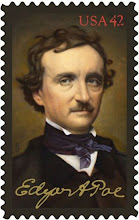“Hop Frog” is a short story by Edgar Allan Poe. It was first published 1849. The title of the story is also the title of the lead character, a dwarf taken from his homeland who becomes the jester of a king particularly fond of practical jokes. The story places Hop Frog, the king and his cabinet at the scene of a party. The king cruelly sets to task to intoxicate the dwarf. The effects of the alcohol initially dull his senses and place him in the scorn of the king. A fellow dwarf named Trippetta tries to placate the king in order to save Hop Frog from abuse. However, the king becomes irate over her behavior and strikes her. Hop Frog, at this time, becomes motivated to take revenge for the striking of his dear Trippetta. To entertain, Hop Frog dresses the king and his council up as orangutans for the masquerade. However, in front of the king's guests, Hop-Frog readjusts the scene and murders them all by hanging them out of reach and setting their costumes afire before escaping with Trippetta. As in “Berenice,” Poe uses again the symbolism of teeth in “Hop Frog” to demonstrate the characters emotions, motivations, and behavior.

The noise and bearing of teeth can be a seen as a sign of aggression. Hop Frog becomes incensed when the king violently pushes Tripetta aside and throws the “[…] brimming goblet […]” of wine in her face (Poe 902). During the silence that follows, everyone hears “[…] a low, but harsh and protracted grating sound which seemed to come at once from every corner of the room […] (Poe 903).” The magnification of the grating sound represents a surge of energy that is aggressive and acutely poignant. The king accuses Hop Frog of making the noise but the dwarf denies the action. The king’s attention is deflected by a courtier. Although relieved by the suggestion, the king takes the opportunity to remark his initial doubt and insult Hop Frog, calling him a vagabond. At first, it would seem Hop Frog has become dismissive, but in the midst of the king’s overtures, Hop Frog takes on his drinking challenge and reveals “[…] a set of large, powerful, and very repulsive teeth […] (Poe 903).” This would foreshadow the events to unfurl.
At the end of this cautionary tale, the sound and visage of Hop Frog’s fangs become emblematic of power, strength, imprisonment, death, and fury. Poe describes the scene of Hop Frog’s with the phrase “[…] dead silence […] (Poe 907).” This silence is broken by the “low, harsh, grating sound, as had before attracted the attention of the king and his councillors, when the former threw the wine in the face of Trippetta. This sound imprisons everyone at the masquerade and subjects them to horrific event – the death of the king and his council. The dwarf’s “[…] maniacal rage […]” emanates from an expression of “[…] fang-like teeth […]” that ground and gnash as foam issues forth from his mouth (Poe 907). Hop Frog’s emotional display is similar to that of the Maori, when they perform the Haka. The Maori people display strong body language, contort their faces, and issue their tongue to create a moving, powerful, and furious display of strength (New Zealand Tourism). Hop Frog’s own facial expressions produce a strength which precipitates revenge upon the people who enslaved him and his fellow dwarf, Trippetta.
Tales of revenge often reveal symbols that detail the intentions of its instigators. Poe, through his use of symbolism, imbues his characters with emotionality and character. Hop Frog’s teeth reiterate his frustration and growing intolerance of the idea of captivity and abuse. His teeth are used to foreshadow key events in the story, which propel Hop Frog’s towards his desire to be free. Overall, without the use of symbolism, Poe stories might not reveal the intensity and grim world in which his characters exist nor provide his readers with an entertaining tale.
Tourism New Zealand. “Haka: A New Zealand Icon.” Video. New Zealand.com. 21 June 2009 < http://www.newzealand.com/travel/app_templates/haka/index_content.html>.
Poe, Edgar Allan. “Hop Frog.” Poe: Poetry, Tales, & Selected Essays. New York: The Library of America, 1996. 899-908.

Post a Comment